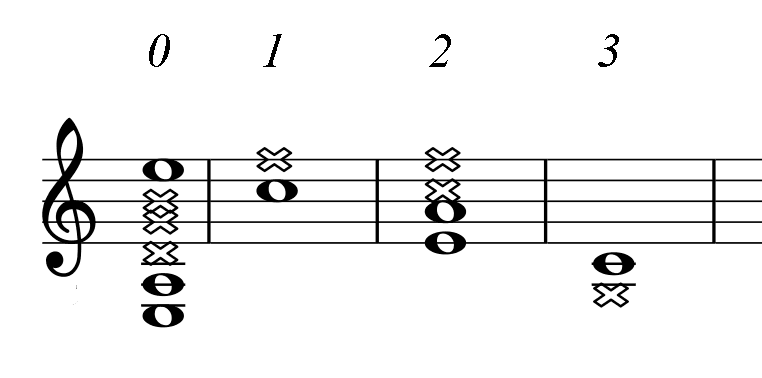
To understand the method, please, review this introduction to the book
Home | Top | What is PAD: Perfectly Aligning Diagrams | How the method was developed | Basic chord fingering chart | Table of PADs in the Book: chords and scales, transposition table | Musical structure of guitar starting with C major scale | Essential guitar scale pattern on the fretboard | Notes along the fingerboard: note C | Grouping of notes across the guitar strings into fret groups | Notes along the strings | Thirds intervals on the Guitar. Exercise | Guitar Triads and Tetrads (Chords), Diagonal Structure, Exercise | Chords and Inverted Chords on a Guitar Fret Group. Exercise | PAD Chord Charts | Working with other keys, C blues scale and A minor scale and key | Importance of Key Signatures | Guitar Ear, Fingering, Memory Training with Visual Musical Notes Presentation | The book | Success without memorizing | Blogs, Forums, Groups
It is so easy to play guitar. One can learn several guitar chords and start playing as soon as fingers are ready without any particular knowledge of musical notation. Isn't that why it is so difficult for a guitarist to learn to read written music, sight reading? What does it mean for a guitarist to "read music" ? Looking at notes and playing them on the guitar. Right away. Without thinking where each note is on the fingerboard. Fingers just jump where they supposed to be. There have to be a mental bridge between a note symbol on the staff (all these circles on and between 5-lines) and fingers which seemingly by themselves press the strings on appropriate frets. Even more than that. By looking at notes a guitarist should "en-hear" how a note is played to correct himself if fingering went wrong, he should take care about the surrounding chord and the whole key it is played in. The business gets complicated: all senses are involved, and tremendous amount of practice time is need. A guitarist virtually lives in the space of written symbols, sounds, finger positions, tactile pressures, and musical logic. And this space is intricate: almost all notes on the guitar can be played in several positions, all of which are important to master. Not to speak that there are 12 keys.
Therefore, any help in immersion of a guitarist into "the world of guitar" and helping him to navigate around is very important. And efficient help is important 1000-fold !
One might ask: "why bother? There are symbols and tabs. I do not need to know all these notes.." The power of standard musical notation over symbolic or tablature methods is overwhelming. Its only drawback is that it is difficult for a guitarist to learn. My goal is to resolve this contradictory situation.
Here is the most intuitive method for mentally associating written on a staff note symbols with fingering. It serves excellent as well in associating familiar left-hand chord positions with representing them note symbols. That trains sight-reading and much more than that.
The essence of the method is to make a picture and present the standard note symbols on it in such a way that the fretboard position of the notes is visibly clear. It perfectly aligns notes with their positions, therefore these pictures are called "Perfectly Aligning Diagrams" or PAD-s. Looking at PADs you immediately are able to observe how notes are positioned on string and frets. You see note symbols and where they are located at the same time! It aligns musical shape with the geometrical shape of fingering positions. This is a wonderful tool for a guitarist to learn, memorize notes, and practice scales, chords, arpeggios, how they are positioned on the guitar fingerboard as well as how they are represented on the musical staff.
For example, here is a familiar pattern of A minor chord in the key C:

Measures represent guitar frets: 1, 2, 3. Measure 0 represents free strings. There are two types of symbols on the staff: regular note symbols and crosses. There are 6 strings, so 6 symbols on a measure make it clear on what string each note is played like it is shown on the fret 0. Note symbols stand for notes played on a fret. A cross stands for a string which is not played. The purpose of crosses is to help recognizing on what strings notes are played. In the case of Am, on free strings, we can deduce that three notes on strings 1, 5, and 6 are played. Strings 2, 3, and 4 are not played and marked with crosses.
There is no need to use all 6 symbols on every measure. We can omit unneeded crosses. Look at the measure 1: it is the fret 1. To find that the note C is played on the second string, only one cross is sufficient. On fret 3 it is convenient to omit crosses above the note: a single cross below the note is sufficient to indicate that the note C is played on the 5-th string. On fret 2, two notes of the chord are played on strings 3 and 4, as crosses above them indicate.
On the next picture you can see the whole fret board. All A minor chord notes and positions are observed. Other PADs are designed this way.

It is easy to see on what string each note is played. For example, on measure 15 a note C is played on the 5-th string since there is one cross below. On other diagrams, notes may have sharps and flats as well as naturals with them. Crosses are positioned on correct note places, but the accidentals are not shown with them to keep it clean. Crosses serve as guides to find out on what string a note is played, nothing else. Numbers near the notes are not fingering. They represent an order of the notes in the Am mode of the C key. For example, number 1 at the side of A notes indicates a root. Root gives the chord its name. The chord is built around these notes. You can find familiar minor chord patterns in the picture. Starting from the fret 12 the pattern repeats the leftmost pattern.
You can play the chord notes using your favorite chord patterns or one by one as a scale. You can learn chord finger positions from this diagram and you can take your favorite chord fingering and learn what notes you actually are playing - it works both ways. Amazingly, while you are looking at these staves, you observe the standard musical notation, but at the same time you realize exactly where the notes are located on the frets. It is easy and intuitive. Take your guitar and try it right now !
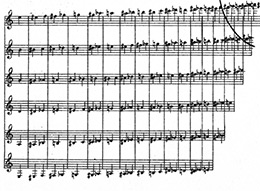 |
Here is how the PAD method could be developed ( in reality, 4 was invented first): | ||
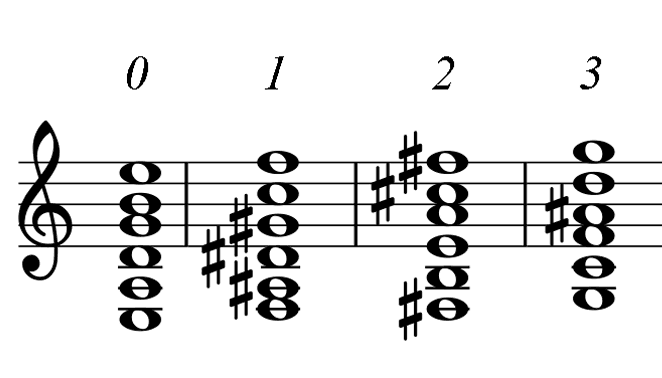 |
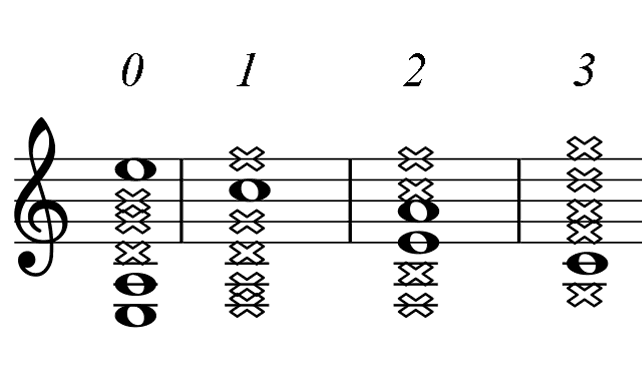 |
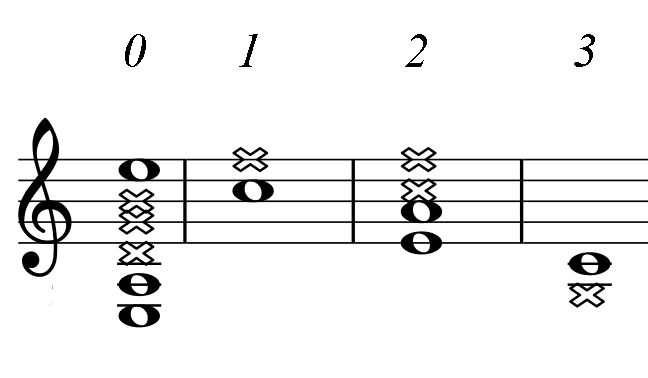 |
|
You can play along and improvise or you can simply memorize what you see in the pictures, say, 15 minutes a day. If you are preparing a musical piece in a certain key, work with this key diagrams, go over each chord one by one and familiarize yourself with the notes and patterns. After this, working with sheet music is easy. Another way is to familiarize yourself with a chord, then look at the major, minor, or blues scale of the key, find the chord notes, and play the scale over your chord. Notes should jump into your mind without noticeable effort. Now you know the pleasure of getting deep into the musical theory. The most important diagram, a pathway to everything else is C major scale guitar PAD, "white piano keys".
In the following chapters you will find many ways to work with the diagrams helping you immerse yourself in the world of guitar.
This book does not have a goal to be an encyclopedia of all available chords. It is meant to be a guitarist's tool for learning notes. Only 21 basic most popular chords for all 12 keys are presented together with major, minor, and blues scales. It will cover about 99% of your needs.
09/13.2011
I have met one guitarist learning guitar for 11 years: "I have trouble in sight reading". Another guitarist, playing guitar for 30 (!) years: "I am not familiar with reading notes beyond 7th fret". Do not get stuck, use this powerful method !
09/04.2011
I have found a sheet of paper signed: "Etude" with a remark: The first in my life note record 11.11.94 ( Numbers ! Look what date this page was published). I play guitar since 1973. Also I have found loads of "guitar chords" - little charts how fingers are positioned on the fretboard. As most of you I did that. I have thrown them to garbage! How stupid I was to waste my time on that.
Browsing through the old papers I have found many notes of my favorite songs. I did not know how to sing them. I always wanted to learn it. Now I take them and ... Wow, I can play notes. Wow! I can play notes! I CAN PLAY NOTES !!!!!!! Can you here that !!!!!!!!!!!!!!!!!!!!!!!!!!!!!!!!!!!!!!
08/28.2011
It is indeed more difficult to learn notes on guitar than on piano. We can say that piano is a one-dimensional instrument, while guitar is two-dimensional: notes are spread along the instrument and across the strings. To deal with patterns in two dimensions is much more complicated than with patterns in one dimension.
Home | Top | What is PAD: Perfectly Aligning Diagrams | How the method was developed | Basic chord fingering chart | Table of PADs in the Book: chords and scales, transposition table | Musical structure of guitar starting with C major scale | Essential guitar scale pattern on the fretboard | Notes along the fingerboard: note C | Grouping of notes across the guitar strings into fret groups | Notes along the strings | Thirds intervals on the Guitar. Exercise | Guitar Triads and Tetrads (Chords), Diagonal Structure, Exercise | Chords and Inverted Chords on a Guitar Fret Group. Exercise | PAD Chord Charts | Working with other keys, C blues scale and A minor scale and key | Importance of Key Signatures | Guitar Ear, Fingering, Memory Training with Visual Musical Notes Presentation | The book | Success without memorizing | Blogs, Forums, Groups
| Available PAD in the key C - Am: | Help | Home | Explanation | Musical Structure of Guitar | Success without memorizing | Forums, Groups | ||
| Notes: | C, D, E, F, G, A, B | ||
| Triads of C major scale: | C, Dm, Em, F, G, Am, Bdim, tetrads: Bm7b5, G7 | ||
| Triads of A minor scale: | E, other: A | ||
| C blues scale | C7, F7, G7 | ||
| Chords over C major scale: | C, G, F, Em, Am, Dm, Bdim | ||
| Chords over A minor scale: | Am, Dm, E, G, C, F, Bdim | ||
| Donate $1 | Buy the Book | Order Custom | Facebook | Add to favorites | Mail to a Friend | Tweet | |
|
Key words: guitar, chord, scale, chart, classical, note, tablature, book, fingerboard, fretboard
Design and Copyright © 2011 Igor Polk. Published by Yes San Francisco, LLC on 2011.01.11